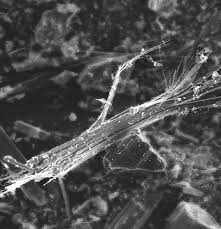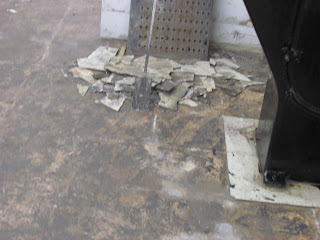We attended the Environmental Information Association (EIA) 2022 National Conference and Exhibition in Phoenix, Arizona from March 20, through March 23, 2022. We attended several sessions regarding asbestos where we discussed with some attendees asbestos clearance air sampling and what are the Federal requirements. Based on those discussions we figured it was time to write an article on this topic. To make sure we wrote this article based on general industry practice, versus what we are used to in New York State and New York City, we consulted with Mr. Tom Laubenthal, of TGL Consulting, Inc., and Mr. Dana Brown, of Time's Dark Captains. Since everything else seems to start with the Environmental Protection Agency's (EPA's) Asbestos-Containing Materials in Schools Rule (40 CFR Part 763, Subpart E, known in the industry as the Asbestos Hazard Emergency Response Act (AHERA)) why don't we start there? The AHERA regulation remember applies to schools from Kindergarten to 12th grade (K-12), both public and private schools. The requirements are found in two sections of the rule:
- Response Actions; §763.90 (i)
- Appendix A (to Subpart E) - Interim Transmission Electron Microscopy Analytical Methods - Mandatory and NonMandatory - and Mandatory Section to Determine Completion of Response Actions
For all intents and purposes, these methods serve as the industry standard when final clearance is performed for most asbestos abatement projects, especially when areas are to be re-occupied. We’ll discuss applicability issues as we go.
 |
| TEM Analysis |
First, let's discuss the requirement for aggressive clearance sampling. In the AHERA regulation, aggressive sampling means floors, ceilings, and walls shall be swept with the exhaust of a minimum one (1) horsepower leaf blower. Some states and specifications may also require the use of fans as described in the non-mandatory section of Appendix A. The non-mandatory section states, that stationary fans shall be placed in locations that will not interfere with the air monitoring equipment. Fan air is directed toward the ceiling. One fan shall be used for every 10,000 cubic feet (CF) of a worksite. This is required in the New York State Department of Labor's Asbestos Regulation Industrial Code Rule 56 (NYSDOL ICR56) and the New York City Department of Environmental Protection Asbestos Regulation Title 15 (NYCDEP Title 15). However, NYSDOL ICR56 also requires one fan per room in addition to the one fan per 10,000 CF.
 |
| This is not in the spirit of the AHERA/NYSDOL ICR56/NYCDEP Title 15 requirements for aggressive clearance sampling. Thank you Greg Mance for the photo. |
As defined by the AHERA rules, final clearance air sampling can be done by phase contrast microscopy (PCM) methodology for projects less than or equal to 160 square feet (SF) or 260 linear feet (LF) by the National Institute for Occupational Safety and Health (NIOSH) 7400 methodology (Issue 3: 14 June 2019 is the current issue). For projects greater than 160 SF or 260 LF clearance shall be done by the AHERA transmission electron microscopy (TEM) method (requirements at 763.90 (i) (4) and Appendix A).
 |
| Graphic courtesy Tom Laubenthal |
There are some similarities between the AHERA TEM and NIOSH 7400 methods. For example, the AHERA TEM method (Appendix A) allows for the use of either a 25-millimeter (mm) filter cassette or a 37-mm filter cassette. We haven't used a 37-mm cassette since the industry switched from the old asbestos sampling method NIOSH P&CAM 239 to the NIOSH 7400 method that was formally adopted into AHERA. For sampling, whether it is the AHERA TEM method or the NIOSH 7400 method, we use a 25-mm 3-piece cassette with 50-mm electrically conductive extension cowl cassettes. The two methods require the filter cassette to face 45 degrees downward from the horizontal. The filter material used is mixed cellulose ester (MCE). AHERA TEM method does allow for the use of polycarbonate (PC) filters as well. The PC filters fell out of favor because post-sampling handling was more problematic than the MCE filters. With PC filters, if samples sent to the lab are not handled carefully, the sampled fibers can move significantly from the filter surface. This was widely discussed in the industry in the 1980s. Since then, only MCE filters are used outside of specialty applications.
 |
| The filter cassette is to face 45 degrees downward from the horizontal. |
Both methods require blanks, however, that is where the similarities end. The AHERA TEM method requires three blanks two field blanks and one laboratory (sealed) blank. While the NIOSH 7400 method requires a minimum of two blanks or 10% of samples collected with a maximum of 10 blanks. How the blanks are handled is different as well. The AHERA TEM method laboratory (sealed) blank is not opened and kept sealed, while the field blanks are opened for 30 seconds at the entrance to each abatement area and one at an ambient area. While the NIOSH 7400 method requires the blanks to be opened at the same time as the other cassettes just prior to sampling and stored with the top covers of the cassettes that are running and remain open for the duration of sampling (here is an interesting difference, in some places the cassettes are stored in the box with the lid closed or, the way we were taught, they are placed in a Ziploc bag that is used to deliver the samples to the laboratory).
 |
| A typical box of air sampling cassettes |
Another difference is that with the AHERA TEM method we use a 0.45-micron (µm) MCE filter and the NIOSH 7400 method uses a 0.8 µm MCE filter. This refers to the size of the air passages in the filter material. Filter manufacturers will color code or mark the label so that the type of filter within the cassette assembly is known to the user and the laboratory.
 |
| TEM filter is 0.45-micron. PCM filter is 0.8-micron. |
Let's get to some of the interesting items such as how the samples are taken and how many are required. The AHERA TEM method is straightforward, it requires 5 samples inside the work area and 5 samples outside the work area that represent air entering the abatement site plus the blanks (as mentioned above) for a total of 13 samples. These samples should run from 1 to less than 10 liters per minute (LPM) for a total volume of air greater than 1199 liters or greater (see Table 1 below for the recommended sampling volume range for this method, typically the volume range is between 1200 liters and 1800 liters). It is interesting that the maximum flow rate is less than 10 LPM. It would be interesting to find out how many in the industry actually sample at less than 10 LPM (i.e., 9.9 LPM versus 10 LPM). Likely most of the industry merely samples at 10 LPM. The statistical difference between 10 and 9.9 LPM, some regulators insist upon, is statistically insignificant and will affect method performance in no discernable manner. Either way, this means your clearance samples will take a little over 2 hours to collect.
 |
 |
In speaking with Mr. Tom Laubenthal, we learned at the time this method was developed it became known through the research involved that flow rates higher than 10 LPM could cause fibers to impact the MCE filters vertically and not horizontally to the filter surface. This makes the sample analysis, counting, and identification, difficult and likely biased. This is also the reason the method specifies a second MCE filter under the 0.45 µm sampling filter and the 5 µm diffuser. This additional filter is placed in this manner to attempt to create an even flow across the filter surface so that fibers impact the filter uniformly. Since the fibers are lying flat on the filter this is the reason for turning the sample upright before interrupting the pump flow to ensure the fibers remain on the filter.
 |
| Sampling Cassette Configuration |
In the AHERA TEM method, the clearance samples pass when the average concentration of the five samples inside the work area does not exceed 70 structures per square millimeter (s/mm2). See AHERA at 763.90 (i) (3) for an optional clearance test based on the z-test which compares the outside and inside air samples. This is rarely necessary. But cases have occurred when contamination can exist in the air outside the work area that could cause a failure in the work area.
 |
| This TEM asbestos image is from the Centers for Disease Control (CDC) "Asbestos Fibers and Other Elongate Mineral Particles: State of the Science and Roadmap for Research" |
The NIOSH 7400 method for final clearance is also interesting when it comes to how the sample is taken and how many are based on the project. For schools, when PCM is allowed, it's 5 samples inside the work area. What's interesting is that the clearance is based on each sample and each sample must be less than or equal to a limit of quantitation (LOQ) for PCM of 0.01 fibers per cubic centimeter (f/cc). Well according to the NIOSH 7400 method how do you achieve clearance at that LOQ? This concept of LOQ is not a concept understood by many that use the NIOSH 7400 method for all its purposes. In the NIOSH 7400 method, this issue is addressed as follows in the section "Sampling", number 4 on page 4. It utilizes the formula below to determine the amount of time needed to achieve the fiber density, E, for optimum filter loading. So, the minimum density the method allows is 100 fibers per square millimeter (mm2). The Ac is the collection area for a 25-mm cassette which is 385 mm2. The Q is the sampling flow rate in LPM, so let's say that is 16 (the maximum flow rate allowed by the method). The L is the concentration of fibers in the air, we are looking to achieve clearance at 0.01 fibers/cubic centimeters (f/cc). So if you plug these numbers into the formula you get a time of 240.6 minutes, which means the sample would have to run for a little over 4 hours at 16 liters per minute (total volume of air of 3,850 liters).
Realize that is running the sample at 16 LPM. If your pump/flowmeter can only go to 15 LPM then you would have to run the sample for 256.7 minutes which is just short of 4 hours and 15 minutes. The lower the flow rate, the longer time it will take to meet sample volume requirements.
 |
| Airbox High-Performance Air Sampler |
Many believe or have been misled to believe that PCM sampling is the same as TEM sampling in terms of sampling volume. This is not the case. A PCM sample volume meeting AHERA clearance requirements are not at 1200 liters. To do so is outside of the NIOSH 7400 method requirements for this purpose. In the NIOSH 7400 method, the issue regarding "relatively clean" environments" is addressed on page 4, number 4, note number 1 which states "In relatively clean atmospheres, where targeted fiber concentrations are much less than 0.1 f/cc, use larger sample volumes (3000 to 10,000 liters) to achieve quantifiable loadings." Even though the formula calculates that 3,850 liters of air should be collected, many people use note 1 to collect 3,000 liters of air for clearance. Either way clearance samples should be collected using no less than 3,000 liters of air as the minimum allowed for the NIOSH 7400 method requirements and AHERA compliance.
 |
| PCM image of fibers |
The true problem is the NIOSH 7400 was never designed as a clearance tool, it was designed as a personal air sampling method. NIOSH and the Occupational Health and Safety Administration (OSHA) still view the method in that manner officially. The other problem with PCM is that all fibers meeting method criteria are counted, not just asbestos fibers. The AHERA TEM method is the only procedure that was designed as a final clearance air sampling method. Only asbestos fibers/structures are counted in the analysis meeting method criteria for size, and those much smaller than can be determined by the PCM.
 |
| EPA's Silver Book |
Realize this is not something out of the ordinary the EPA's publication "Measuring Airborne Asbestos Following An Abatement Action" (otherwise known as the Silver Book) written in November 1985 on page 2-6 recommends the sample volume for the PCM analysis should be a minimum of 3,000 liters of air (though at the time of this publication it was describing the NIOSH P&CAM 239 PCM methodology). In addition, in March 2015 the EIA published a revision to the EPA's 1985 document "Guidance for Controlling Asbestos-Containing Materials in Buildings"(EPA 560/5-85-024, known as the Purple Book). This nationally peer-reviewed document was re-titled "Managing Asbestos in Buildings: A Guide for Owners and Managers." Chapter 5 (on page 88) says the minimum sampling volume of 3,000 liters of air for samples taken to meet the NIOSH 7400 method requirements for LOQ sampling. Mr. Dana Brown did a video regarding the LOQ issue and why NIOSH 7400 method is not the best choice for clearance, you can see it below.
This doesn't count that we have called for the AHERA TEM method to be utilized for asbestos-containing floor tiles and mastic removals based on our previous blog post "Asbestos Floor Tile Debate", published in the August 2017 issue of Healthy Indoors Magazine, which found that the NIOSH 7400 method is not able to analyze the type of fibers (Grade 7-Shorts and Floats that are known to be less than 5 microns) found in these materials because of the known small fiber sizes generated by floor tile work. Whether AHERA-based work or asbestos abatement where re-occupancy will occur, the surest way to make sure an area is ready to be given back to the public to be free of asbestos as practicable by current methods, and the fastest method for clearance would be the AHERA TEM method.
 |
| NYSDOL ICR56 Definition of an Asbestos Project |
Of course, those of you who work in New York State or New York City realize these requirements only apply to public and private K-12 schools. So they don't apply to other buildings, or do they? First, let's take the NYSDOL ICR56 Subpart 56-4, page 35 is the air sampling requirements. 56-4.6 "Test Methods" on page 36 says "the same NIOSH approved methodology for project air sampling and for analysis of the air samples shall be used at all phases of an asbestos project that require area air sampling and analysis, with the possible exception of clearance air sampling." This means that the NIOSH 7400 method must be followed for all phases except clearance (Phase IIC of the asbestos project) this allows you to use either the NIOSH 7400 method or the AHERA TEM method instead for clearance. So this means you have to follow the NIOSH 7400 method's LOQ requirements for all phases (Phase I B and Phase II A, B, & C) of the asbestos project. In addition, the NYSDOL ICR56 regulation for clearance is less than 0.01 f/cc so that changes the formula again. Let's use 0.009 f/cc for the L instead and still use 16 liters per minute, well that means the sample has to run for 267 minutes, almost 4 hours, and 30 minutes (a total volume of air of 4,278 liters).
 |
The consummate leader cultivates the moral law, and strictly adheres to method and discipline; thus it is in his power to control success. ~ Sun Tzu |
So why does everyone sample 1,200 liters of air for all samples? On April 8, 2011, the New York State Department of Health (NYSDOH) Wadsworth Center issued frequently asked questions (FAQs) regarding asbestos/fibers analysis that were developed through the collaboration of the NYSDOH Environmental Laboratory Approval Program (ELAP) and the Bureau of Occupational Health and the NYSDOL. In this FAQ is FAQ#13: What is the minimum sampling volume to be collected for air sampling associated with (a) post-abatement (clearance) air monitoring and (b) post-abatement area monitoring for PCM analysis? The answer that was given was: Within the upcoming revision to NYS Industrial Code Rule 56, minimum air sample volume requirements
 |
| Buy our Asbestos Air Sampling Chart here. Read about our Asbestos Air Sampling Charts here. |









